World War II, Europe.
The dawn of the year 1943 finds Adolf Hitler at the beginning of serious trouble. Since September of 1939, the world had lived through the horror and impotence of three years of continuous victories by the German juggernaut. Hitler’s mechanized infantry, unstoppable panzers, relentless artillery and screaming Stukas had effectively steamrolled over Poland, then Norway, Denmark, France and Belgium. Once Western Europe had fallen, the yellow eyes and salivating fangs of the Hun had turned East, where it had flattened the Baltic countries of Latvia, Estonia, and Lithuania and exploded like a tidal wave into Russia. However, its momentum was finally brought to a halt at the river Volga, where both Soviet army and civilians were at that moment waging against the Wehrmacht in the greatest battle the world had ever fought: Stalingrad.Meanwhile, the British Isles were still being suffocated in the stronghold of the Kreigsmarine’s submarine wolfpacks, threatening to sever the vital artery of food, supplies, fuel, arms and ammunition sailing from the New World. American and British ingenuity would soon change the course of this so-called War of the Atlantic, with new sonar and radar technologies, as well as better depth charges and aerial reconnaissance ending what German submariners would later call the “happy years”.When Operation Sea Lion, his plan to invade the British Isles, was finally foiled, his unfulfilled dreams of Albion’s demise had him foaming at the mouth. His vindictive nature compelled him to order his generals and engineers to bring to fruition his Vergeltungswaffen project. That’s German for retaliatory or vengeance weapons, using just the letter “V” and a numeral to differentiate among the different weapons being conceived. The idea was to terrorize the populations of allied cities, and to avenge the damage that allied bombers were inflicting on Germany. In total, there were three V weapons, two of them missiles and the third a monstrous set of cannons.The V-1 “Flying Bomb” was a pulse-engine rocket missile that took off from a ramp in locations across Southern France and was aimed to fall in London. The V-1 was an early attempt at an automatic guided bomb. It was initially an effective weapon even though later, its low speed made it possible for RAF fighters to chase it successfully and shoot it down or made it deviate from its path. Famously, there are anecdotes of RAF pilots slowly approaching the V-1s from behind, and carefully tipping them with a wing of their Spitfires, and watching the bomb lose control and crash harmlessly in the water or in the British countryside.
The idea was to terrorize the populations of allied cities, and to avenge the damage that allied bombers were inflicting on Germany. In total, there were three V weapons, two of them missiles and the third a monstrous set of cannons.The V-1 “Flying Bomb” was a pulse-engine rocket missile that took off from a ramp in locations across Southern France and was aimed to fall in London. The V-1 was an early attempt at an automatic guided bomb. It was initially an effective weapon even though later, its low speed made it possible for RAF fighters to chase it successfully and shoot it down or made it deviate from its path. Famously, there are anecdotes of RAF pilots slowly approaching the V-1s from behind, and carefully tipping them with a wing of their Spitfires, and watching the bomb lose control and crash harmlessly in the water or in the British countryside.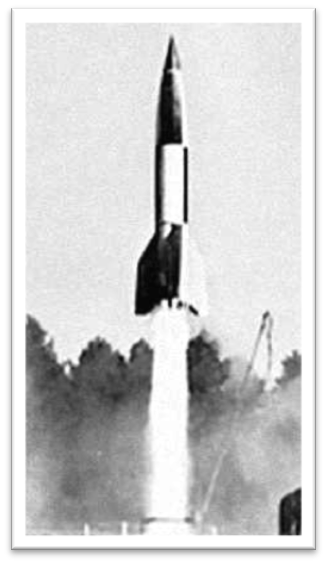 The V-2 is probably the most famous rocket of WWII. Its designer, Wernher von Braun, would eventually join NASA and contribute greatly to the US space program. This was a supersonic rocket that flew a very high ballistic trajectory, launching vertically from fixed and mobile sites in occupied Europe. It was huge, about the size of a 4-story building, and capped with a metric ton of high explosives. More than three thousands of these were successfully launched against allied cities, 95% of them crashing against both London and the Belgian city port of Antwerp, on the Scheldt river. This monstrous rocket fell vertically down at supersonic speeds and in eerie silence onto terrorized civilians. There wasn’t a technology in the world capable of stopping a V-2 during the later stages of its flight path, which is why all efforts to counter this weapon were focused in destroying its launch sites. V-2s killed over 7.000 people throughout the war.The Vergeltungswaffen 3 (V-3) is at the heart of our story and the most unusual of the three mega weapons. It was designed to be a set of 25 super guns or long-range cannons located in an underground fortress near the small village of Mimoyecques, in Northern France.Before we go any further, we must provide some measure of scale to understand the potential of this weapon. The largest artillery piece the allies ever fired during the war was the American M1 240mm Howitzer. This behemoth cannon could fire a shell weighing 163 Kg, 23 kilometers away, but the cannons of the V-3 could shoot a similarly heavy high explosive projectile more than SEVEN times further! Not only could they impact a target 165 Kilometers away, but there would be a total of twenty-five such guns, so the Germans would soon acquire the ability to decimate London from a distance from which the allies could not reciprocate. All this while shooting from a heavily reinforced, impregnable and reinforced concrete bunker.Knowing that the allies would eventually find out about its existence and try to destroy it, as they would the V-2 testing and manufacturing grounds at the eastern island of Peenemunde later in the war, the German engineers in charge of the manufacturing
The V-2 is probably the most famous rocket of WWII. Its designer, Wernher von Braun, would eventually join NASA and contribute greatly to the US space program. This was a supersonic rocket that flew a very high ballistic trajectory, launching vertically from fixed and mobile sites in occupied Europe. It was huge, about the size of a 4-story building, and capped with a metric ton of high explosives. More than three thousands of these were successfully launched against allied cities, 95% of them crashing against both London and the Belgian city port of Antwerp, on the Scheldt river. This monstrous rocket fell vertically down at supersonic speeds and in eerie silence onto terrorized civilians. There wasn’t a technology in the world capable of stopping a V-2 during the later stages of its flight path, which is why all efforts to counter this weapon were focused in destroying its launch sites. V-2s killed over 7.000 people throughout the war.The Vergeltungswaffen 3 (V-3) is at the heart of our story and the most unusual of the three mega weapons. It was designed to be a set of 25 super guns or long-range cannons located in an underground fortress near the small village of Mimoyecques, in Northern France.Before we go any further, we must provide some measure of scale to understand the potential of this weapon. The largest artillery piece the allies ever fired during the war was the American M1 240mm Howitzer. This behemoth cannon could fire a shell weighing 163 Kg, 23 kilometers away, but the cannons of the V-3 could shoot a similarly heavy high explosive projectile more than SEVEN times further! Not only could they impact a target 165 Kilometers away, but there would be a total of twenty-five such guns, so the Germans would soon acquire the ability to decimate London from a distance from which the allies could not reciprocate. All this while shooting from a heavily reinforced, impregnable and reinforced concrete bunker.Knowing that the allies would eventually find out about its existence and try to destroy it, as they would the V-2 testing and manufacturing grounds at the eastern island of Peenemunde later in the war, the German engineers in charge of the manufacturing 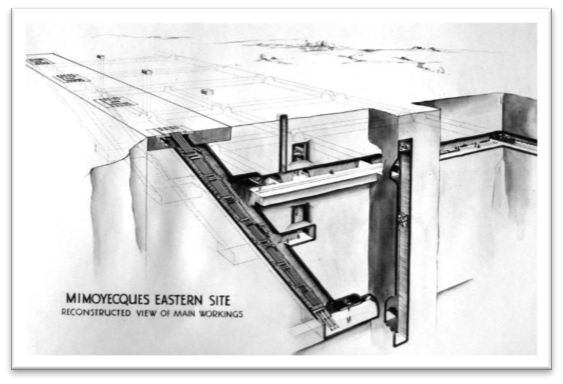 and installation of the V-3 came up with a radical idea. They buried the cannons under several meters of reinforced concrete where no bombs would damage them. This curiously meant that the cannons were firmly lodged in concrete and pre-aimed. They could not be moved to change the direction of their projectiles, although their range could be modified by changing the power of its initial firing force. Also, different shells could be used to vary the effect of the shell’s impact.The Mimoyecques location was selected due to its proximity to England, 160 Km to the heart of London, and a final configuration of five separate modules of five super-cannons each was constructed, for a total of twenty fiveThe way the German engineers managed to speed up the projectile so it could reach London is ingenious and terrifying at the same time…But I digress, as usual.This is where our TV camera and our Catholic president-to-be enter the story.The allies found out about the site only after the construction had been underway for months and the main reinforced roof of the installation was in place. Early attempts to destroy the site by conventional bombing were unsuccessful, so a new approach was needed and soon.Both the USA and Britain had secret projects underway that might be the solution, so both countries embarked, in coordination with each other, on the manufacturing and testing of their own device.The British relied on the legendary ingenuity and prowess of engineer and inventor Barnes Wallis, responsible for the design of the “Bouncing Bomb” that the allies successfully employed to destroy many German hydroelectric dams. The mission using these bombs inspired the 1955 movie “The Dam Busters” in which Mr. Willis is played by Michael Redgrave.In this case, Barnes Wallis further developed the idea to create a super bomb, so heavy and shielded at the front that it would not explode on contact, but instead would penetrate the ground to a point where the explosion would cause a mini-earthquake. The destruction of the target would come from extreme vibration of the surrounding soil as opposed to an air blast, as in conventional ordnance.
and installation of the V-3 came up with a radical idea. They buried the cannons under several meters of reinforced concrete where no bombs would damage them. This curiously meant that the cannons were firmly lodged in concrete and pre-aimed. They could not be moved to change the direction of their projectiles, although their range could be modified by changing the power of its initial firing force. Also, different shells could be used to vary the effect of the shell’s impact.The Mimoyecques location was selected due to its proximity to England, 160 Km to the heart of London, and a final configuration of five separate modules of five super-cannons each was constructed, for a total of twenty fiveThe way the German engineers managed to speed up the projectile so it could reach London is ingenious and terrifying at the same time…But I digress, as usual.This is where our TV camera and our Catholic president-to-be enter the story.The allies found out about the site only after the construction had been underway for months and the main reinforced roof of the installation was in place. Early attempts to destroy the site by conventional bombing were unsuccessful, so a new approach was needed and soon.Both the USA and Britain had secret projects underway that might be the solution, so both countries embarked, in coordination with each other, on the manufacturing and testing of their own device.The British relied on the legendary ingenuity and prowess of engineer and inventor Barnes Wallis, responsible for the design of the “Bouncing Bomb” that the allies successfully employed to destroy many German hydroelectric dams. The mission using these bombs inspired the 1955 movie “The Dam Busters” in which Mr. Willis is played by Michael Redgrave.In this case, Barnes Wallis further developed the idea to create a super bomb, so heavy and shielded at the front that it would not explode on contact, but instead would penetrate the ground to a point where the explosion would cause a mini-earthquake. The destruction of the target would come from extreme vibration of the surrounding soil as opposed to an air blast, as in conventional ordnance.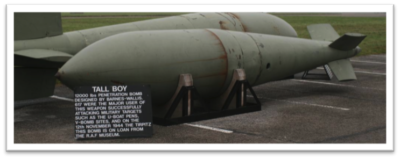 The plan was approved and the super bombs were built, and aptly named “Earthquake Bombs”, these in particular were named “Tall Boys”. The name of the various attempts against Nazi mega weapons using this super bomb was known as Operation Crossbow. A Tallboy was also used to sink the Tirpitz, the only sister ship of the mighty Bismarck, flagship of the German navy, in a Norwegian fjord.On July 17, 1944, the British launched their attack and 17 Lancaster bombers, the only ones capable of taking off with the weight of the Tall Boys. The bombs were so massive that they did not fit inside the plane, and were carried under the plane’s fuselage. The Lancasters took off from a secret location in England and bombed Mimoyecques. The following day aerial reconnaissance aircraft took precision photos of the site and discovered eight enormous craters close enough to the structure to cause damage but the roof appeared intact.Given the uncertainty of catastrophic damage to the V-3 installation, the Allies approved moving forward with the American contingency plan.The Americans had decided on a different route than just a bomb dropped from a plane and for that, Brigadier General Grandison Gardner had been tapped to come up with an alternative. General Gardner is recognized today as an American pioneer in drones and automated/remotely operated aircraft. To develop a solution to bomb the V-3 sites, General Gardner commissioned his engineers at Eglin Field, Florida, were he was in charge of the Air Proving Ground Command, to outfit worn-out bombers with automatic pilots and TV cameras so that they could be remotely controlled. While cutting edge at the time, these were primitive initial attempts at automation using remote control signals and real-time streaming video. The Operation was christened “Aphrodite”. There were two TV cameras installed, one aimed to the outside through the windshield to provide the remote pilot with a view of where the aircraft was headed and the second was focused on the instruments, to provide the flight engineer with information about navigation and engines.This was the first time the US Air Force would tinker with remotely controlled aircraft, or drones, during war. The idea was to load a Consolidated B-24 with 12 tons of Torpex, a British explosive 50% more powerful than TNT, and then fly and crash the automated airplane into Mimoyecques to destroy the V-3 installations.Unfortunately the B-24 drone was not capable of taking off on its own and this is where our third hero (remember? Drone, TV camera and Catholic American president?) enters the picture.
The plan was approved and the super bombs were built, and aptly named “Earthquake Bombs”, these in particular were named “Tall Boys”. The name of the various attempts against Nazi mega weapons using this super bomb was known as Operation Crossbow. A Tallboy was also used to sink the Tirpitz, the only sister ship of the mighty Bismarck, flagship of the German navy, in a Norwegian fjord.On July 17, 1944, the British launched their attack and 17 Lancaster bombers, the only ones capable of taking off with the weight of the Tall Boys. The bombs were so massive that they did not fit inside the plane, and were carried under the plane’s fuselage. The Lancasters took off from a secret location in England and bombed Mimoyecques. The following day aerial reconnaissance aircraft took precision photos of the site and discovered eight enormous craters close enough to the structure to cause damage but the roof appeared intact.Given the uncertainty of catastrophic damage to the V-3 installation, the Allies approved moving forward with the American contingency plan.The Americans had decided on a different route than just a bomb dropped from a plane and for that, Brigadier General Grandison Gardner had been tapped to come up with an alternative. General Gardner is recognized today as an American pioneer in drones and automated/remotely operated aircraft. To develop a solution to bomb the V-3 sites, General Gardner commissioned his engineers at Eglin Field, Florida, were he was in charge of the Air Proving Ground Command, to outfit worn-out bombers with automatic pilots and TV cameras so that they could be remotely controlled. While cutting edge at the time, these were primitive initial attempts at automation using remote control signals and real-time streaming video. The Operation was christened “Aphrodite”. There were two TV cameras installed, one aimed to the outside through the windshield to provide the remote pilot with a view of where the aircraft was headed and the second was focused on the instruments, to provide the flight engineer with information about navigation and engines.This was the first time the US Air Force would tinker with remotely controlled aircraft, or drones, during war. The idea was to load a Consolidated B-24 with 12 tons of Torpex, a British explosive 50% more powerful than TNT, and then fly and crash the automated airplane into Mimoyecques to destroy the V-3 installations.Unfortunately the B-24 drone was not capable of taking off on its own and this is where our third hero (remember? Drone, TV camera and Catholic American president?) enters the picture. 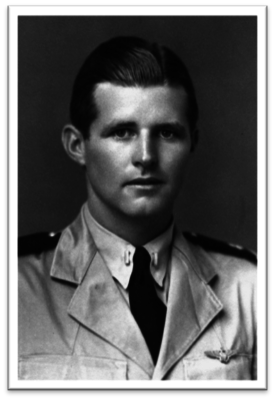 Joseph Patrick Kennedy Jr. was the eldest of nine children born to Joseph P. Kennedy Sr. and his wife Rose Fitzgerald and he was being groomed from birth to be the first catholic president of the USA. This is not a figure of speech, literally the day that Joe Jr. was born, his father, one of the richest men in the USA announced to the press that his son “…would be the first catholic president of the United States of America.”Joe Kennedy was a Lieutenant pilot in the USA Air Force in 1944 when Operation Aphrodite against the super gun was given a green light and he volunteered to fly the mission.He had over 50 flights patrolling the Atlantic Ocean looking for German U-Boats and never saw a glimpse of one. According to Joe Kennedy Sr. biographer, Cari Beauchamp, Joe Jr. saw this opportunity of destroying Hitler’s super gun as his chance to glory.His co-pilot was Wilford John, “Willy”. The plan was for them to take off on the loaded bomber codenamed “Baby” and fly it to an altitude of 2,000 ft. Following them in another plane was the crew that would eventually take control of the flight and remotely control the bomber to Mimoyecques.The top-secret mission was scheduled for August 12, 1944 and the plane was loaded with the explosives and the electronic panel that the engineers in Eglin field had design to trigger the bomb. A few days before the flight a young officer by the name Earl Olsen, a self taught electronic enthusiast, reviewed the panel on the B-24 built by the Eglin team and found a possibly catastrophic flaw in the remote firing mechanism: The trigger mechanism was to be fired remotely using a radio signal. In order to prevent any stray signal to trigger the explosives while the crew was still in the airplane, they had put a pin that blocked the trigger from activating. This pin was supposed to be removed by the pilot just before they parachuted off the plane. The problem that Olsen found was that, even with the pin in place, radio signals would still activate the circuit and, while most of the current was blocked by the pin, enough current would flow so that it could send a detonation signal to the explosives. He frantically tried to warn his commanding officer but his objections were shut down.In 2011, just a few months before his death, Olsen gave an interview in which he described his efforts to stop the flight. He actually described in excruciating detail how he warned Joe Jr. personally and his commanding officers about the flaw in the design and construction of the prototype electronic device. Olsen was dismissed by the officers in charge and the mission went ahead as planned.Olsen last words to Kennedy were: “If you are going to fly this mission, jump from the aircraft as soon as you arm the bomb. Don’t wait; this might give you enough time to escape.”According to the logs of the event, Kennedy and Willy successfully took off and remained aboard the modified B-24 until it completed its first remote-controlled turn at 2,000 feet near the North Sea coast. Kennedy and Willy removed the safety pin from the bomb, arming the explosive package, and Kennedy radioed the agreed code Spade Flush, his last known words.Two minutes later (and well before the planned crew bailout), the Torpex explosive detonated prematurely and destroyed the airplane in a huge, bright explosion, killing Kennedy and Willy instantly. Wreckage spread near the village of Blythburgh in the Blyth estuary on the Easternmost coast of England, causing widespread damage and fires. According to one report, a total of 59 buildings were damaged in the coastal town.No remains of either Kennedy or Willis were ever found and the story of the presumed first Catholic President of the USA changed forever.Upon hearing of the news of his older brother’s death, John F. Kennedy is rumored to have said “The burden is now on me…”And the rest is history.Six decades later, a WWII historian by the name of Nick Sparks finally, through a freedom of information act request, found a secret document containing the electronic diagram of the infamous panel and proceeded to rebuild an exact replica of the device. The flaw was in plain sight, a wrongly located switch allowed current to flow to the trigger solenoids once the safety pin was removed, causing the devices to overheat and set off the Torpex.The ironic corollary to this story is that the Tall Boy attack on Mimoyecques of July 17 had actually destroyed the underground compound, obliterating the semi assembled V-3 super gun. Canadian troops who reached the site a few days after Kennedy’s death confirmed the complete destruction of the site, even though the reinforced concrete roof was still almost intact.Unfortunately for Kennedy and Willy, aerial photographs of the site after this bombing did not show any particular damage on the surface, even though the site was abandoned by troops and workers a few days later. The superstructure protecting the V-3 cannons was so strong that, even though the Tall Boy entered the ground surrounding the bunker as designed and detonated inside, the huge explosion, while destroying the cannons and most likely killing every soldier inside, was contained by the reinforced concrete dome, and the damage could not be assessed by aerial reconnaissance.It could be said that Kennedy and Willy died in vain and the first catholic president of the USA was JFK instead of JPK. Special thanks to Pablo K. Ramos of Houston, TX who helped with the photos and the historical framework for the story.
Joseph Patrick Kennedy Jr. was the eldest of nine children born to Joseph P. Kennedy Sr. and his wife Rose Fitzgerald and he was being groomed from birth to be the first catholic president of the USA. This is not a figure of speech, literally the day that Joe Jr. was born, his father, one of the richest men in the USA announced to the press that his son “…would be the first catholic president of the United States of America.”Joe Kennedy was a Lieutenant pilot in the USA Air Force in 1944 when Operation Aphrodite against the super gun was given a green light and he volunteered to fly the mission.He had over 50 flights patrolling the Atlantic Ocean looking for German U-Boats and never saw a glimpse of one. According to Joe Kennedy Sr. biographer, Cari Beauchamp, Joe Jr. saw this opportunity of destroying Hitler’s super gun as his chance to glory.His co-pilot was Wilford John, “Willy”. The plan was for them to take off on the loaded bomber codenamed “Baby” and fly it to an altitude of 2,000 ft. Following them in another plane was the crew that would eventually take control of the flight and remotely control the bomber to Mimoyecques.The top-secret mission was scheduled for August 12, 1944 and the plane was loaded with the explosives and the electronic panel that the engineers in Eglin field had design to trigger the bomb. A few days before the flight a young officer by the name Earl Olsen, a self taught electronic enthusiast, reviewed the panel on the B-24 built by the Eglin team and found a possibly catastrophic flaw in the remote firing mechanism: The trigger mechanism was to be fired remotely using a radio signal. In order to prevent any stray signal to trigger the explosives while the crew was still in the airplane, they had put a pin that blocked the trigger from activating. This pin was supposed to be removed by the pilot just before they parachuted off the plane. The problem that Olsen found was that, even with the pin in place, radio signals would still activate the circuit and, while most of the current was blocked by the pin, enough current would flow so that it could send a detonation signal to the explosives. He frantically tried to warn his commanding officer but his objections were shut down.In 2011, just a few months before his death, Olsen gave an interview in which he described his efforts to stop the flight. He actually described in excruciating detail how he warned Joe Jr. personally and his commanding officers about the flaw in the design and construction of the prototype electronic device. Olsen was dismissed by the officers in charge and the mission went ahead as planned.Olsen last words to Kennedy were: “If you are going to fly this mission, jump from the aircraft as soon as you arm the bomb. Don’t wait; this might give you enough time to escape.”According to the logs of the event, Kennedy and Willy successfully took off and remained aboard the modified B-24 until it completed its first remote-controlled turn at 2,000 feet near the North Sea coast. Kennedy and Willy removed the safety pin from the bomb, arming the explosive package, and Kennedy radioed the agreed code Spade Flush, his last known words.Two minutes later (and well before the planned crew bailout), the Torpex explosive detonated prematurely and destroyed the airplane in a huge, bright explosion, killing Kennedy and Willy instantly. Wreckage spread near the village of Blythburgh in the Blyth estuary on the Easternmost coast of England, causing widespread damage and fires. According to one report, a total of 59 buildings were damaged in the coastal town.No remains of either Kennedy or Willis were ever found and the story of the presumed first Catholic President of the USA changed forever.Upon hearing of the news of his older brother’s death, John F. Kennedy is rumored to have said “The burden is now on me…”And the rest is history.Six decades later, a WWII historian by the name of Nick Sparks finally, through a freedom of information act request, found a secret document containing the electronic diagram of the infamous panel and proceeded to rebuild an exact replica of the device. The flaw was in plain sight, a wrongly located switch allowed current to flow to the trigger solenoids once the safety pin was removed, causing the devices to overheat and set off the Torpex.The ironic corollary to this story is that the Tall Boy attack on Mimoyecques of July 17 had actually destroyed the underground compound, obliterating the semi assembled V-3 super gun. Canadian troops who reached the site a few days after Kennedy’s death confirmed the complete destruction of the site, even though the reinforced concrete roof was still almost intact.Unfortunately for Kennedy and Willy, aerial photographs of the site after this bombing did not show any particular damage on the surface, even though the site was abandoned by troops and workers a few days later. The superstructure protecting the V-3 cannons was so strong that, even though the Tall Boy entered the ground surrounding the bunker as designed and detonated inside, the huge explosion, while destroying the cannons and most likely killing every soldier inside, was contained by the reinforced concrete dome, and the damage could not be assessed by aerial reconnaissance.It could be said that Kennedy and Willy died in vain and the first catholic president of the USA was JFK instead of JPK. Special thanks to Pablo K. Ramos of Houston, TX who helped with the photos and the historical framework for the story. 

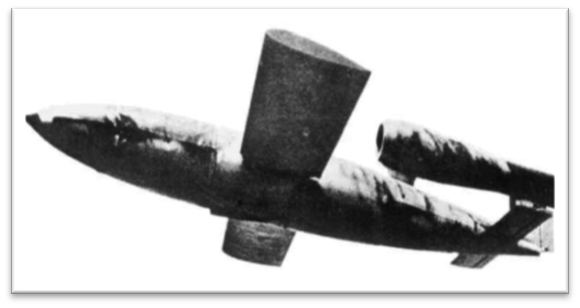












Comments